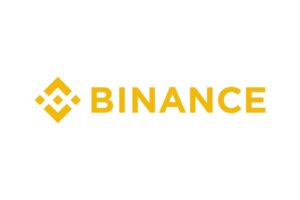Binance Cloud Mining Review 2025 – Is It Worth Investing?

Binance Cloud Mining is a cryptocurrency mining service that lets users mine Bitcoin and other supported cryptocurrencies without the need for physical mining equipment or technical setup. Unlike traditional mining, cloud miners simply purchase or rent mining contracts through Binance, and the platform manages everything on the backend, including hardware, electricity, cooling, and ongoing maintenance.
As the name implies, this service is offered by the global Binance platform, an exchange that stands out for its large trading volume, robust security measures, and extensive product offerings, including Web3 integration. In addition, Binance offers a token launchpad and launchpool, allowing developers to launch new tokens. Traders can also buy these tokens at lower prices before they hit the market.
This Binance Cloud Mining review will explain how the service works and what sets it apart. We will also explore the top features of the Binance Cloud Mining app, Binance Pool cloud mining fees, and provide a step-by-step guide on how to use Binance Cloud Mining to help you get started with your own mining contract.
| Rating | 4.6/5  |
| Security | 9.5/10 |
| Available Cryptocurrencies | 9/10 |
| Customer Service | 9.5/10 |
| User Experience | 8.5/10 |
| Is it Safe? | Yes |
Binance Cloud Mining Review – What Is It? A Comprehensive Look

Binance Cloud Mining is a crypto mining service provided by the global crypto exchange via Binance Pool. It allows users to mine Bitcoin and other cryptocurrencies without owning or managing physical mining hardware. Miners can purchase or rent cloud mining contracts that represent a certain amount of mining power (hashrate). This allows them to mine cryptocurrencies like Bitcoin and receive a share of the mining rewards from Binance’s mining pools.
Binance operates large-scale mining infrastructure to optimize the mining process in areas with cheap electricity and optimized cooling. When you purchase a cloud mining plan, you are simply buying a portion of the hashrate (mining power) generated by this infrastructure and getting daily payouts in return.
Each plan specifies details such as the cryptocurrency being mined, the amount of hashrate you’re entitled to, the duration of the contract (180 or 360 days), the estimated output during mining, and the associated costs, including electricity and maintenance fees. Once you’ve purchased a cloud mining plan, your share of the mining output is credited to your Binance account daily.
Please note that the amount you earn depends on the current network difficulty, the total hashrate you’ve rented, and the market price of the mined asset. Additionally, Binance Cloud Mining doesn’t guarantee profits. Rewards fluctuate based on market prices, mining difficulty, and network competition.
To give you an overview of how Binance Pool Cloud Mining works, here’s a table summarizing the key features of the service and more:
| Service | Cloud-based crypto mining |
| Company | Binance. Supports cloud mining through Binance Pool. |
| Requirements | Binance account |
| Supported Cryptocurrencies | BTC, ETHW, ECT, BCH, LTC, DOGE, PEPE, CFX, ZEC, RVN, DASH, KAS, and CKB. |
| Payout Frequency | Daily |
| Contract Type | Fixed-term contracts (duration varies, could go up to 360 days) |
| Minimum Purchase | Average 1 TH/s |
| Hardware Maintenance | Fully managed by Binance |
| Electricity Cost | Included in the contract’s price |
| Security and Uptime | Handled by Binance’s secure, industrial-grade facilities |
| Withdrawal Support | Rewards are sent directly to the user’s Spot Wallet and can be withdrawn after they are deposited. |
| Available in the US? | No |
What Are the Pros and Cons of Binance Cloud Mining?
The pros of Binance Cloud Mining are ease of use, low entry barrier, no need for hardware maintenance, support from a trusted platform, flexible mining contracts, real-time monitoring, reduced technical knowledge requirements, and access to competitive mining rates. Let’s explore each advantage in more detail:
- Ease of Use: Binance Pool, the cloud mining platform, has a clean, intuitive, and simplified interface, making it easy for anyone to understand, regardless of experience level. To speed up the learning process, Binance provides video tutorials to guide users on cloud mining, how it works, and how to purchase a contract.
- Low Entry Barrier: With Binance Pool Cloud Mining, you do not need to invest thousands of dollars to start mining. Binance offers miners the opportunity to begin with as little as the contract allows (could go as low as $5, depending on the token, hashrate fee, and electricity cost). This opens the door for retail investors who would otherwise be priced out of traditional mining.
- No Hardware Maintenance: Since everything is hosted in the cloud, users are not responsible for purchasing, setting up, or maintaining any mining tools. This removes the stress of dealing with hardware breakdowns, electricity bills, or cooling systems. Binance handles all the technical operations and infrastructure, allowing you to focus solely on tracking your rewards and returns.
- Backed by a Trusted Platform: Binance is one of the largest crypto exchanges by trading volume and a globally recognized crypto trading company. Its reputation for strong security, transparent operations, and established infrastructure adds a layer of trust to the cloud mining service.
- Flexible Mining Contracts: You can select from various mining durations and power allocations based on your goals and budget. This flexibility gives investors better control over the level of risk or exposure to take on. It also allows you to diversify your mining strategy by testing short-term or long-term contracts without locking up large capital.
- Real-Time Monitoring and Transparency: The platform offers live mining statistics so that you can track earnings, contract performance, and operational metrics directly from your dashboard. With this, you can easily see how your investment performs without relying on third-party tools.
- No Technical Expertise Required: You don’t need to understand blockchain protocols or mining algorithms. Everything is pre-configured, and Binance handles the backend so you can focus on returns without learning complex systems. This makes it an ideal entry point for newcomers who want to participate in Bitcoin mining without the steep learning curve.
- Competitive Mining Fees and Electricity Rates: Binance uses large-scale mining farms to negotiate better electricity deals and mining pool access. As a result, miners often benefit from more favorable profit margins compared to personal setups.
Meanwhile, the cons of Binance Cloud Mining are limited profitability, lack of asset ownership, risk of contract expiration losses, availability restrictions in some regions, no hardware control, and platform dependency.
- Limited Profitability: While cloud mining is convenient, it reduces your margin. You share profits with the platform, and returns are often lower than owning and operating your mining rig.
- You Do Not Own Any Physical Assets: Since all mining is done remotely, you do not own the machines or infrastructure generating income. This makes it difficult to repurpose your investment if contracts become unprofitable. Moreover, without hardware ownership, you have no resale value or long-term asset control to fall back on.
- Risk of Expiration Without ROI: Mining contracts come with fixed durations. If the market becomes unfavorable, your contract may expire before you recover your investment, especially during low-yield mining periods. In such cases, miners are left with no revenue or recourse.
- Regional Restrictions: Binance Cloud Mining is not accessible in every country. Regulatory limitations in some regions, including the United States, prevent users from accessing or using the service legally. Therefore, checking your local laws and Binance’s supported areas is essential before attempting to purchase a mining contract.
- No Control Over Hardware or Setup: You cannot customize your mining hardware or adjust the environment to optimize performance. This lack of control means you rely entirely on Binance’s operational decisions and conditions.
- Full Dependence on Binance’s Ecosystem: If the platform experiences downtime, changes terms, or discontinues the service, your ability to mine and earn will be disrupted. There is little room for autonomy once you are locked into a contract.
Is Binance Cloud Mining Legit or Safe to Use?
Yes, Binance Cloud Mining is legit and safe to use. It is operated by Binance, one of the world’s largest and most reputable cryptocurrency exchanges. User funds and mining contracts are managed within the Binance ecosystem, which implements robust security measures like cold wallet storage and regular audits to secure users’ funds.
What Are Binance Cloud Mining Supported and Restricted Countries?
Binance Cloud Mining is supported in most regions where the main Binance platform is legally permitted. Some of these regions include Argentina, Australia, Belgium, Brazil, Bulgaria, Chile, Czech Republic, Denmark, Egypt, Finland, France, Germany, Hungary, India, Indonesia, Italy, Japan, Mexico, Mongolia, New Zealand, Philippines, Poland, Portugal, Romania, South Africa, Spain, Switzerland, Taiwan, Turkey, Vietnam, and over 100 more countries globally.
Binance Cloud Mining restricted countries are the United States, Canada (Ontario), the United Kingdom, the Netherlands, Afghanistan, Belgium, Cuba, Iran, Syria, North Korea, Crimea and Sevastopol, Donetsk People’s Republic, Luhansk People’s Republic (Ukraine), and other sanctioned or high-risk jurisdictions.
Can You Use Binance Cloud Mining in the US?
No. Binance Cloud Mining is not available in the United States. The cloud mining service was launched exclusively via the Binance global platform, which expressly excludes US residents from participation. While Binance provides a different trading platform for US investors. However, the cloud mining service is unavailable on that version.
What Are The Top Features of Binance Cloud Mining App?
The top features of the Binance Cloud Mining app are no hardware needed, transparent contracts, real-time monitoring, and expanded risk considerations. These features simplify the mining process for users while improving transparency, control, and ease of use.
No Hardware Needed
In traditional mining, individual miners or companies invest in specialized devices like ASIC miners or GPU rigs. These machines are expensive, power-hungry, and generate much heat and noise. You also need a stable power supply, ventilation or cooling systems, dedicated space, and the technical knowledge to manage everything from firmware updates to hashrate optimization.
With Binance Cloud Mining, you do not need any physical mining equipment. This means you can start mining coins with a few taps on your phone and not worry about investing in expensive hardware, maintaining the devices, or handling cooling systems. The mining operations are handled entirely by Binance’s infrastructure, saving you space, money, and energy costs.
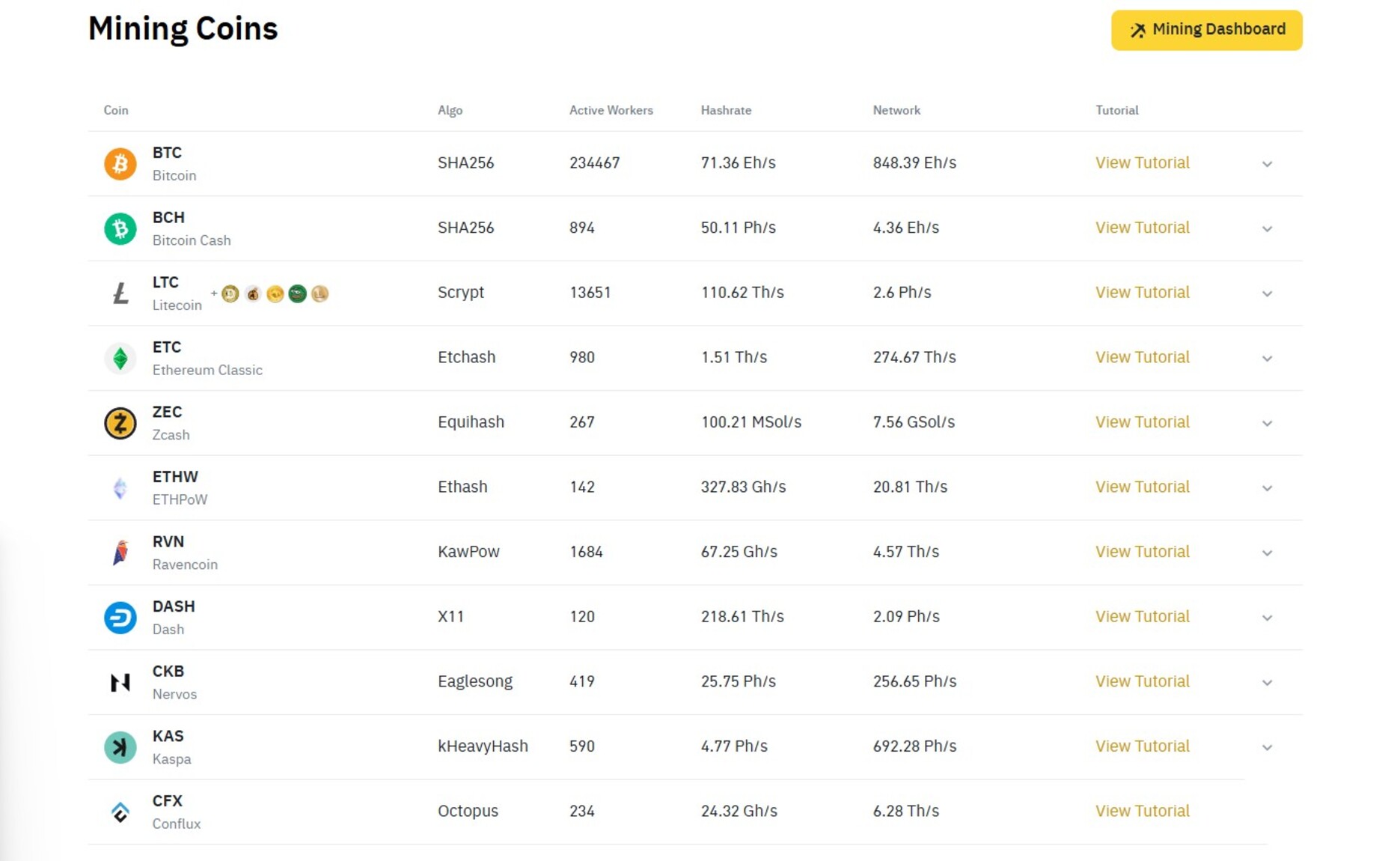
Transparent Contracts
Another strong feature of Binance Cloud Mining is the transparency of its contracts. Before you commit your funds, Binance provides complete details about each contract. These include the computing power you are buying, how long the contract will last, how much it costs, and how your earnings will be calculated.
To clarify, each contract page outlines the estimated daily output, the mining pool involved, electricity costs, and any applicable maintenance fees. This level of openness is helpful for beginners who may not understand how mining works. It also builds trust by giving users everything they need to make informed decisions before investing.
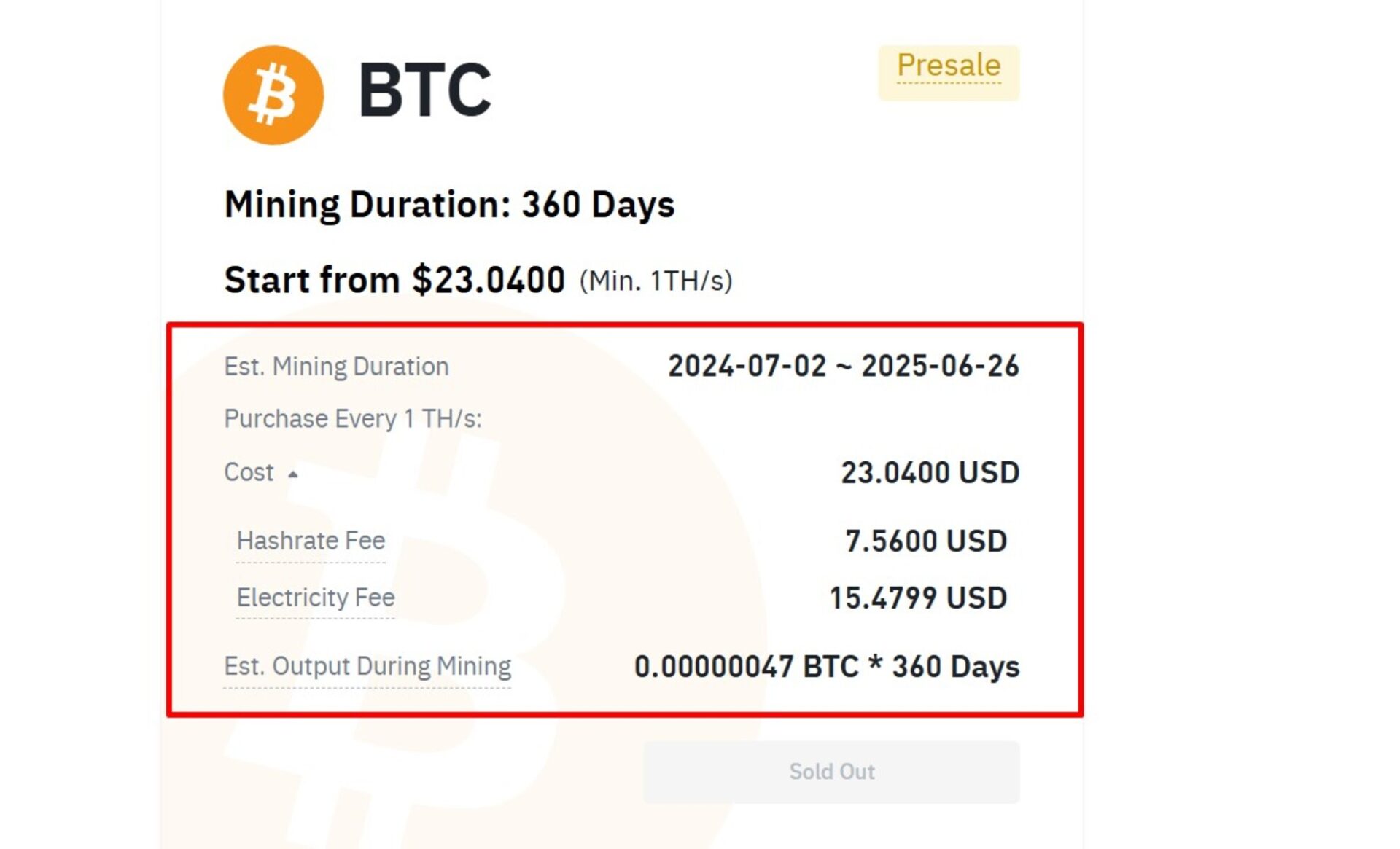
Real-Time Monitoring
Once you purchase a cloud mining plan on Binance Pool, you can access a dedicated dashboard that shows your mining status in real time. This includes your hashrate allocation (how much mining power you’ve rented), the cryptocurrency you are mining, your earnings so far, and the daily output you are receiving.
You can see how much BTC or crypto you’ve earned daily, how many days are left on your contract, and how consistent your mining returns are over time. In addition, the dashboard updates regularly to reflect changes in mining difficulty or any payout fluctuations that might affect your earnings. If Binance’s mining infrastructure goes under maintenance or any temporary downtime, you’ll see it reflected in your mining logs or status alerts.
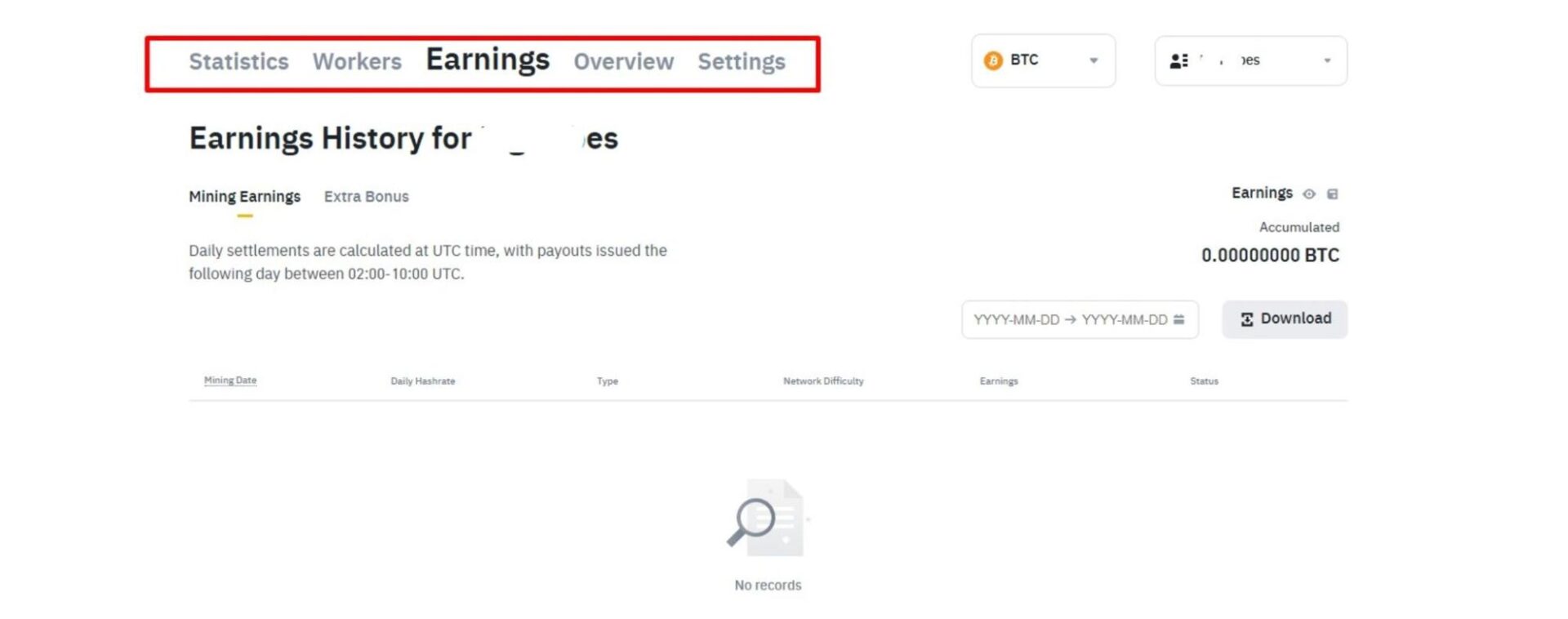
Expanded Risks and Considerations
Binance makes sure that miners understand the risks involved. As there are no profit guarantees with cloud mining. Your returns can be affected by many factors, such as the market price of the crypto asset, mining difficulty, and the network’s performance. Even though the process is simple, the results can still vary widely.
Additionally, Binance does not offer refunds for mining contracts, so you should only commit funds you can afford to lose. For this reason, we strongly encourage miners to carefully review all Binance Pool terms and think through the investment.
Register on Binance today and start cloud mining Bitcoin and other crypto assets with just a few taps.
What Are Binance Cloud Mining Fees, Withdrawal, and Costs?
Binance Cloud Mining comes with specific costs tied to mining contract usage. The main Binance Cloud Mining fees are the hashrate fee and the electricity fee.
Note: The following are only Binance Cloud Mining fees. Other costs, such as withdrawal fees, trading commissions, and staking fees, fall under Binance’s general platform fee structure.
Hashrate Fee
The hashrate fee is the upfront cost to purchase mining power for your cloud mining contract. This power is measured in terahashes per second (TH/s) and determines how quickly your contract can mine crypto assets like Bitcoin. For instance, a hashrate of 20TH/s means the mining system can perform 20 trillion hash calculations per second. The higher the hashrate, the more computing power you have, the better your chances of earning rewards.
Miners with higher hash rates can process more calculations per second, increasing their likelihood of being the first to solve the cryptographic puzzles required to validate new blocks on the blockchain. This process is what generates mining rewards.
Now, when you select a contract, you pay a fixed fee based on the hashrate you choose and the contract’s duration. This fee helps cover the cost of Binance’s mining infrastructure, electricity, and system maintenance. Since the contract is fully managed, operating or configuring any hardware yourself is unnecessary. Binance clearly displays all costs before you confirm your order, allowing you to estimate potential rewards upfront.
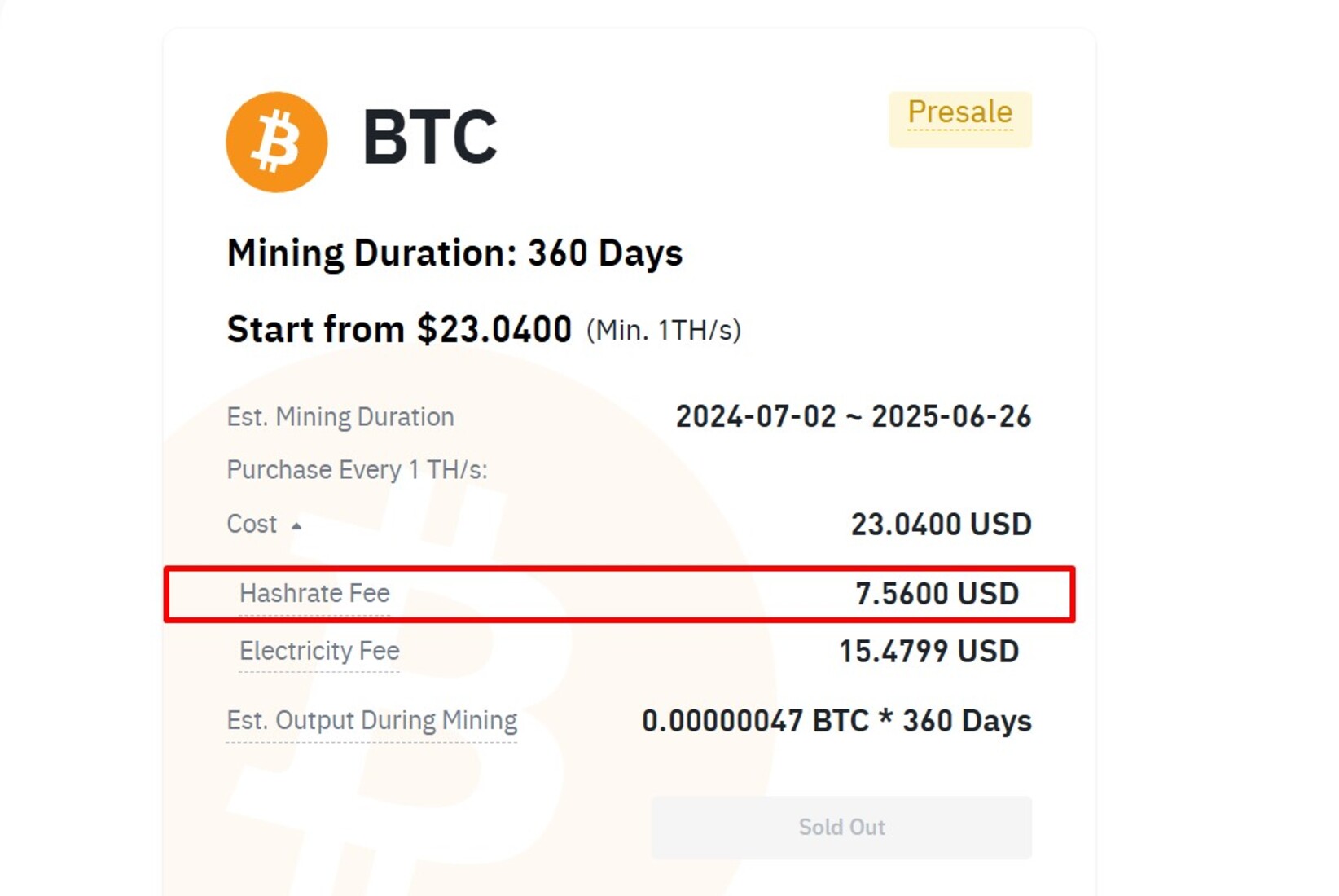
Electricity Fee
Alongside the hashrate fee, users also pay an electricity fee. This covers the power consumed by Binance’s physical mining servers. While you do not handle the equipment, the cost of powering those machines is passed on to you as part of the contract. Depending on the contract terms, this fee might be deducted daily from your rewards or paid in full during checkout. Please note that the rate varies based on energy market prices and the hashrate you purchase, but Binance makes these costs transparent during the purchasing process.
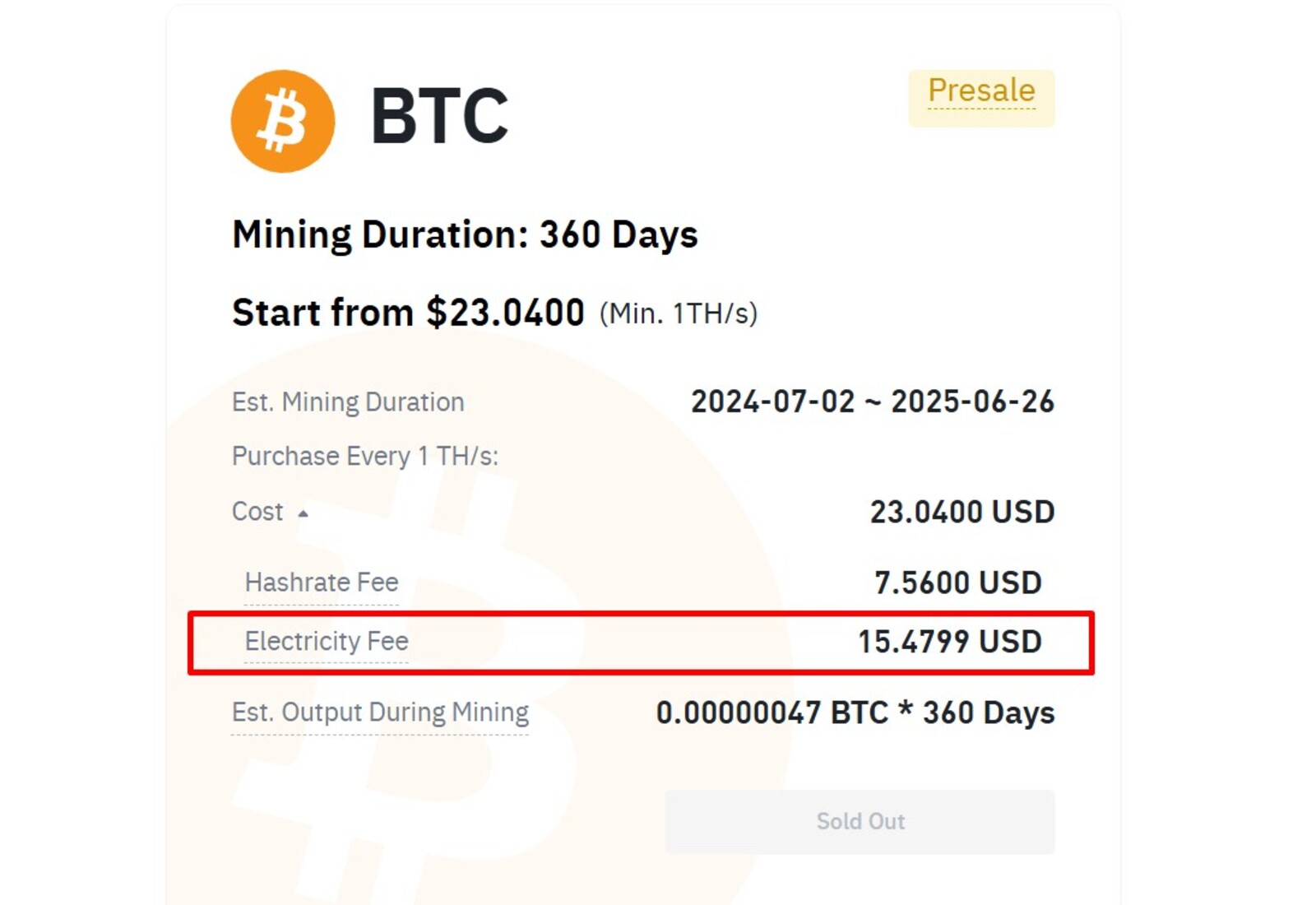
Example & Profitability Calculator for Binance Cloud Mining
Here is a quick and simple example to help you understand the cost and potential profit when using Binance Cloud Mining:
- Fee 1 (Hashrate Fee): $23 for 1 TH/s of mining power (30-day contract)
- Fee 2 (Electricity Fee): $15 for power consumption over 30 days
- Total Cost: $38 upfront
Let’s assume your 1 TH/s generates 0.0005 BTC in 30 days. If Bitcoin is priced at $100,000, your mining reward would be:
- Profit: 0.0005 BTC × $100,000 = $50
In summary, you would spend $38 and earn $50 worth of Bitcoin, resulting in a net profit of $12.
Please note: This is a simplified example, your actual earnings may be higher or lower depending on multiple factors.
How to Use Binance Cloud Mining: Step-by-Step Guide
To use the Binance Cloud Mining service, you must first log in to Binance or join if you don’t have an account. Then navigate to the cloud mining section, choose a contract, make payment, and track your earnings. Here is a detailed guide to help you get started:
Step 1: Log in to Your Binance Account
Go to the Binance official website and log in. If you don’t have an account yet, check out this Binance review for a step-by-step guide on how to create one, complete the identity verification process, and fund your mining account.

Step 2: Go to the Cloud Mining Section
If you use the mobile app, go to the Binance wallet homepage and find the “Earn” tab. Then select “Pool” to access the Cloud Mining service. If you are using Binance on PC, go to your home page and click “More” at the top of the screen. Then click “Mining Pool” to see the available contracts and pricing details.
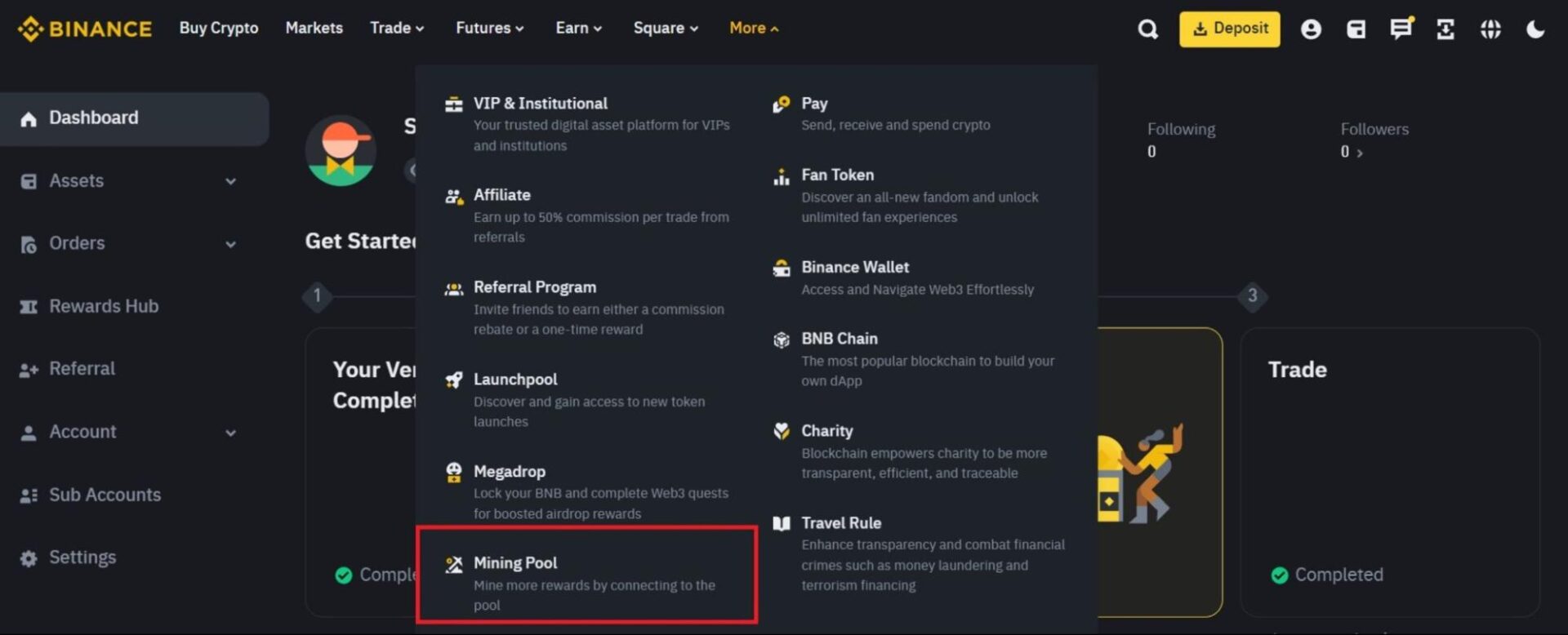
Step 3: Create a Mining Account and Choose a Contract
Click “Create Mining Account” to set up your profile and start mining. Add all the required information, agree to the Binance Pool Service Agreement, then select “create.” Your account will be created immediately, and you can browse through the available mining options on Binance Pool. Look at the hashrate, contract duration, electricity fee, and total cost, and pick one that suits your budget and goals.
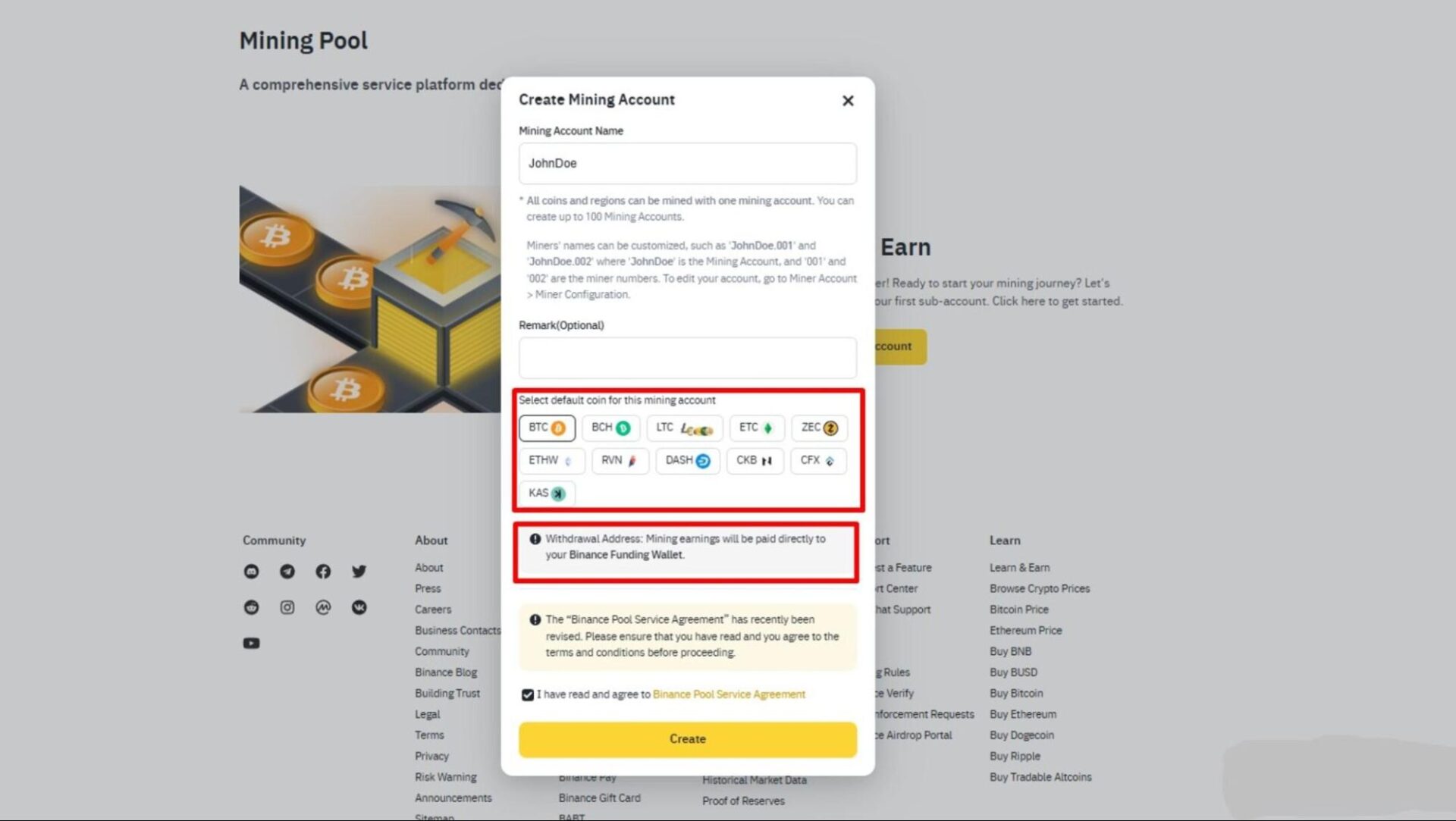
Step 4: Make Payment and Confirm Purchase
Pay using your crypto balance (USDT or BNB). Binance will show the cost breakdown before you confirm. Once confirmed, your contract becomes active. Finally, go to your Cloud Mining dashboard to monitor your earnings, review daily mining output, and see how much BTC you generate.
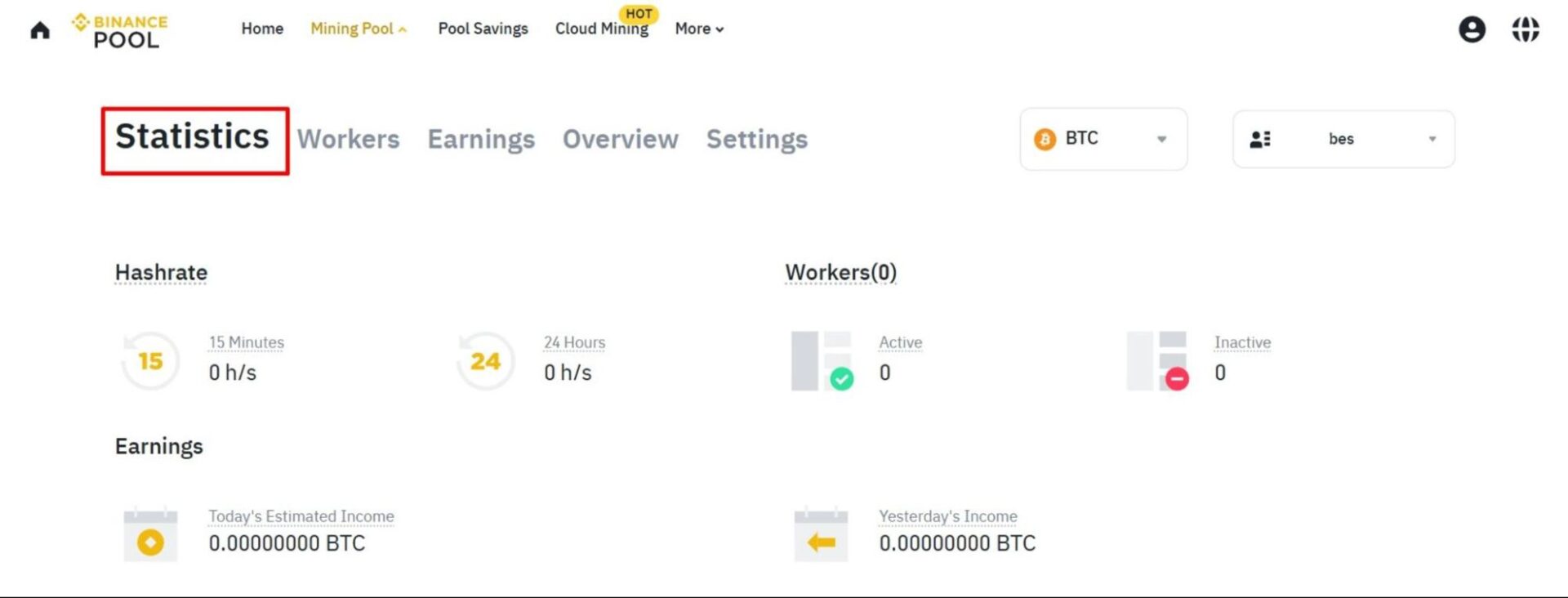
What Are Some Tips and Guides for Using Binance Cloud Mining?
Here are four smart factors to keep in mind before or while using Binance Cloud Mining:
- Fee Rates May Vary Between Contract Rounds or Promotions: Every contract round or promotional event has different pricing. Sometimes, the hashrate fee or electricity cost could slightly shift. Make it a habit to review each contract before confirming your order. This small step can save you from unexpected charges and help you make better investment decisions.
- Total Cost Increases Linearly With Hashrate: If you double your hashrate, let’s say, from 1 TH/s to 2 TH/s, your total cost and daily mining fee will double too. Binance does not offer discounts for larger purchases, so plan your spending carefully based on your risk appetite. Since there’s no price break for buying more, each additional unit of hashrate carries the same weight on your budget.
- Binance Compensates if Uptime Drops Below 95%: One advantage of using Binance is that if uptime dips below 95 percent, they either extend your contract or refund part of your mining fee. It is a fair way to protect your investment from server interruptions. This ensures you’re not paying full price for reduced performance, which adds an extra layer of reliability to the service.
- Payouts are in Crypto, so Track Price Volatility: Your rewards are paid in the specific crypto you are mining, which means market fluctuations can affect your real profit. If the currency’s price drops after your payout, your earnings may lose value. To stay ahead, monitor the crypto’s price trends and consider when to convert your mined coins.
Finally, the crypto industry offers multiple opportunities for investors who want to earn passive income while trading. If you’re searching for options beyond cloud mining, check out this compilation of top cryptocurrency exchanges. Use this Binance referral code during registration and get a free $100 crypto sign-up bonus — a generous offer to support new users
Join Binance today and start your crypto mining journey with a $100 free trading credit and a 20% lifetime discount on fees.
The post Binance Cloud Mining Review 2025 – Is It Worth Investing? appeared first on CryptoNinjas.

